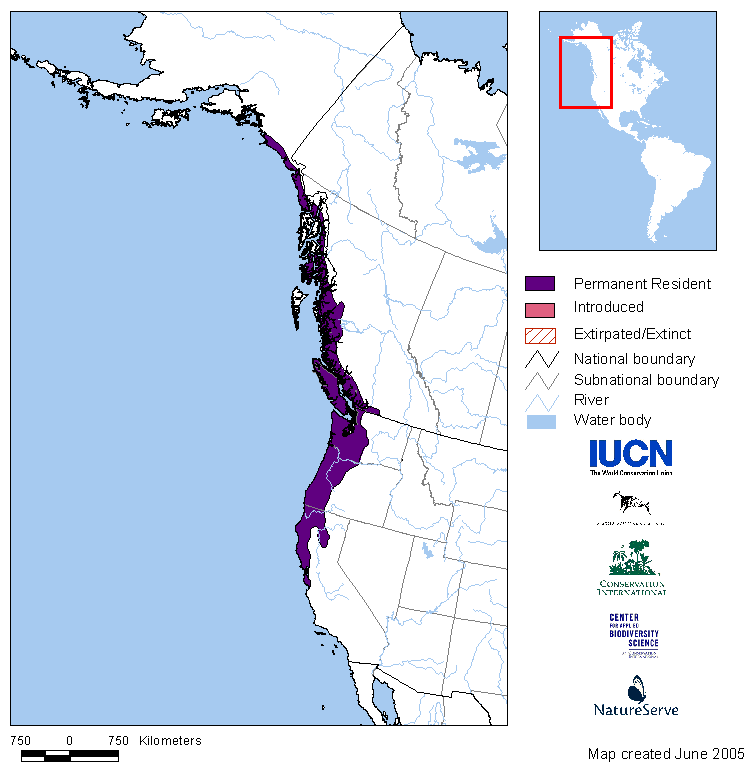Habitat
The Rough-skinned Newt (Taricha
granulosa) lives exclusively in the coastal northwest of
North America ranging from Santa Cruz County, California in the
south to southeastern Alaska in the north. In California they
range eastward to around Shasta County (ADW
2008). There are also a few remote populations in
Latah
County, Idaho which are thought to be introduced (Nature
Serve 2013). More recent research has lead scientists to
believe that the Idaho population is either native or introduced
from a population out of Oregon or Washington based on genetic
research (Kuchta and Tan 2005).
According to Kuchta and Tan (2005), northern populations are not
as genetically diverse as southern populations due to a more
recent range expansion. This expansion was caused by glaciers
receding and having a small section of the previously northern
most population move in. This is also known as the founders
effect and the newt began migrating north at the end of the last
ice age, about 10,000 years ago
(Kuchta
and Tan 2005). It can be found from sea-level to about 9,200
feet in elevation (Nature Serve 2013).
T. granulosa can live in a variety of habitats
(terrestrial or aquatic) as long as they are near water or
moist. They live in forested areas such as coniferous forests,
mixed forests, deciduous forests, but also inhabit savanna (Nature
Serve 2013). They live around or near water bodies such as
ponds, marshes, lakes, slow moving creeks or temporary pools and
prefer to have vegetation nearby. Aquatically they are benthic,
which means that they live or reside at the bottom of bodies of
water, and terrestrially live under moist logs or soil and
debris (Nature Serve 2013). They
can be found out in the open after rainfalls. Rough-skinned
Newts prefer calm, slow moving water or still ponds for breeding
and/or living in (ADW 2008). They
are active either diurnally (meaning daytime) or nocturnally and
prefer moderate temperatures. When on l and, they spend most of
their time in underground burrows or under cover (Amphibiaweb
2013). Adults will spend about half of their life out of
water and will return to the water to mate (Amphibiaweb
2013). Adults locally migrate to mate with some travelling
distances up to several hundred meters, with male newts
migrating about a month before females to the breeding site (Nature
Serve 2013). At higher elevations the newts will mate in the
summer and early fall, and at lower elevations they will mate in
the spring from January to May (ADW
2008). For more info on reproduction see the
Reproduction page. Male and
female newts spend different amounts of their life on land and
in the water, with males spending an average of 8 months in the
water and females spending on average 6 months in the water.
Both males and females overwinter on land (Amphibiaweb
2013). It is possible, however, for a newt to spend its
entire life in water and have been found as deep as 12 meters
underwater. This usually occurs at higher elevations and the
newts retain their gills ion this case (ADW
2008). They will also seasonally migrate depending on
rainfall and temperature from aquatic environments to
terrestrial ones and vice versa. The Rough-skinned Newt is not a
territorial animal (Amphibiaweb 2013).
and, they spend most of
their time in underground burrows or under cover (Amphibiaweb
2013). Adults will spend about half of their life out of
water and will return to the water to mate (Amphibiaweb
2013). Adults locally migrate to mate with some travelling
distances up to several hundred meters, with male newts
migrating about a month before females to the breeding site (Nature
Serve 2013). At higher elevations the newts will mate in the
summer and early fall, and at lower elevations they will mate in
the spring from January to May (ADW
2008). For more info on reproduction see the
Reproduction page. Male and
female newts spend different amounts of their life on land and
in the water, with males spending an average of 8 months in the
water and females spending on average 6 months in the water.
Both males and females overwinter on land (Amphibiaweb
2013). It is possible, however, for a newt to spend its
entire life in water and have been found as deep as 12 meters
underwater. This usually occurs at higher elevations and the
newts retain their gills ion this case (ADW
2008). They will also seasonally migrate depending on
rainfall and temperature from aquatic environments to
terrestrial ones and vice versa. The Rough-skinned Newt is not a
territorial animal (Amphibiaweb 2013).